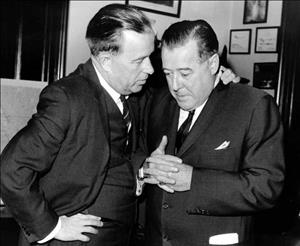On November 5, 1940, Democrats capture all six of Washington's seats in the United States House of Representatives, as well as the Senate seat that is up for election. Twenty-eight-year-old Henry M. "Scoop" Jackson (1912-1983) of Everett wins the race for the open seat in the Second District and becomes the youngest member of Congress. Warren G. Magnuson (1905-1989) of Seattle is re-elected to the House from the First District for a third term. Monrad C. Wallgren (1891-1961) of Everett, who previously held the Second District seat won by Jackson, is elected to the Senate. Washington's other senator at the time, Homer T. Bone (1883-1970), is also a Democrat, so the party holds all eight of the state's seats in Congress -- six representatives and two senators.
In 1940, Henry Jackson was the crusading young prosecuting attorney of Snohomish County. He had been elected to the post two years earlier, ousting an incumbent blamed for corruption, and quickly garnered publicity leading raids against bootlegging and gambling establishments. He made more headlines in 1940 when he prosecuted a brutal double murder, winning a conviction and a death penalty verdict.
Chain Reaction
A political chain reaction gave Jackson the opportunity to move up to Congress. Senator Lewis B. Schwellenbach (1894-1948) was appointed to a federal judgeship, leaving his Senate seat up for grabs in the 1940 election. Two-term governor Clarence Martin (1933-1941) was expected to take the seat, but chose to run for another term as governor. When Martin bowed out of the Senate race, Everett Congressman Mon Wallgren gave up the Second District House seat he'd held since 1933 to seek election to the Senate.
Wallgren encouraged Jackson to run for the House seat, but he encouraged others too, and six candidates sought the Democratic nomination. John Salter, a natural political strategist who had managed Jackson's campaign for prosecuting attorney, ran the House campaign. He relied on young volunteers and door-to-door campaigning, which had worked successfully in the earlier election. When opponents tried to make an issue of Jackson's youth, Salter (who was also 28 -- he and Jackson had met as 12-year-olds having their tonsils out) used the youth issue to Jackson's advantage, issuing press releases that referred to "Energetic, young Henry M. Jackson, a new face" (Prochnau and Larsen, 98). Jackson outpolled his five opponents in the Democratic primary, besting the nearest contender by 3,000 votes.
New Deal Platform
In the general election, Jackson and the other Democratic candidates for Congress benefited from President Franklin D. Roosevelt's (1882-1945) large margin of victory in Washington -- FDR took 58 percent of the vote in the state, beating Wendell Wilkie 462,145 to 322,123. Jackson ran on a platform supporting Roosevelt's New Deal, advocating public ownership of power utilities and a federal old-age pension act. He defeated Republican Payson Peterson with 57 percent of the vote (66,314 votes to 49,209). Jackson entered the 77th Congress in January 1941, as its youngest member. He remained in Congress for the rest of his life, serving six terms in the House, then winning six terms in the Senate before he died in 1983, less than a year after his final election victory.
In the 1940 election, Warren Magnuson easily won re-election in the First District, defeating Fred J. Wettrick 62 percent to 38 percent (113,988 votes to 71,110). Democrats Martin F. Smith (Third District), Knute Hill (Fourth), Charles H. Leavy (Fifth), and John M. Coffee (Sixth) were elected in the state's other House districts. Wallgren won the Senate seat, taking 54 percent (404,718 votes) to Republican Stephen F. Chadwick's 46 percent (342,589 votes). One exception to the Democratic sweep in Washington was that Governor Martin, who sought a third term instead of running for the Senate, lost the governor's race to Republican Seattle mayor Arthur B. Langlie.
Scoop and Maggie Remain
Of the all-Democrat Congressional delegation elected in 1940, only Magnuson and Jackson remained six years later. In 1946, voter resentment over wartime price controls and a backlash against the labor movement led to Democratic losses across the country. Republican Harry P. Cain (1906-1979) won the Senate seat that Mon Wallgren had given up in 1944 to run for governor, by defeating Wallgren's appointed successor Hugh B. Mitchell (1907-1996). Republicans won every House of Representatives seat from the Pacific Northwest except Jackson's, which Jackson held with 53 percent of the vote (the narrowest margin of his career) against perennial Republican challenger Peterson, who he had beaten easily in 1940, 1942 and 1944. Magnuson, who had been elected to the Senate in 1944, was not up for election in 1946.
In 1952, Jackson joined Magnuson in the Senate. "Scoop" and "Maggie" served together in the Senate for 28 years, until Magnuson's 1980 defeat by Slade Gorton (b. 1928). They used their considerable legislative skills and increasing seniority to give the state unprecedented influence in the nation's capital.

